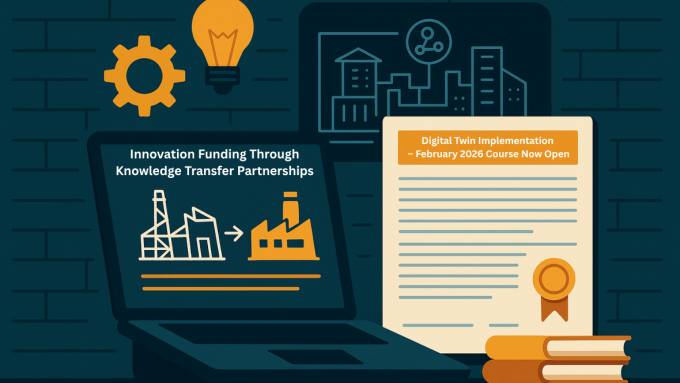The bigger and more complicated the engineering problem, the more likely it is to have a digital twin. Firms that build rockets, planes and ships, for example, have been creating digital twins since the early 2000s, seeing significant operational efficiencies and cost-savings as a result. To date, however, few firms have been able to realise the full potential of this technology by using it to develop new value- added services for their customers. We have developed a framework designed to help scale the value of digital twins beyond operational efficiency towards new revenue streams.
In spite of the hype surrounding digital twins, there is little guidance for executives to help them make sense of the business opportunities the technology presents, beyond cost savings and operational efficiencies. Many businesses are keen to get a greater return on their digital twins’ investment by capitalising on the innovation – and revenue generating – opportunities that may arise from a deeper understanding of how customers use their products. However, because very few firms are making significant progress in this regard, there is no blueprint to follow. New business models are evolving but the business opportunities for suppliers, technology partners and end-users is yet to be fully documented.
Most businesses will be familiar with the business model canvas as a tool to identify current and future business model opportunities. Our ‘Four Values’ (4Vs) framework for digital twins is a more concise version of the tool, developed to help executives better understand potential new business models. It was designed from a literature review and validated and modified through industry interviews. The 4Vs framework covers: the value proposition for the product or service being offered, the value architecture or the infrastructure that the firm creates and maintains in order to generate sustainable revenues; the value network representing the firm’s infrastructure and network of partners needed to create value and to maintain good customer relationships; and value finance such as cost and revenue structures.
Value proposition
The value proposition describes how an organisation creates value for itself, its customers and other stakeholders such as supply chain partners. It defines the products and services offered, customer value (both for customers and other businesses) as well as the ownership structure. Examples of digital twin-based services include condition monitoring, visualization, analytics, data selling, training, data aggregation and lifespan extension. Examples of customer value in this context might include: decision support, personalisation, process optimisation and transparency, customer/operator experience and training.
Value architecture
The value architecture describes how the business model is structured. It has 5 elements: 1. Value control is the approach an organisation takes to control value in the ecosystem. For example, does it exist solely within its own ecosystem of digital twin services or does it intersect with other ecosystems? 2. Value delivery describes how the digital twins are delivered, are they centralised, decentralised or hybrid? It also seeks to understand any barriers that may prevent the delivery of digital twins to customers. 3. Interactions refers to the method of customer interaction with the digital twin. Common examples of interaction include desktop or mobile app, virtual reality and augmented reality interactions. 4. Data collection underlies the digital twin value proposition and can be a combination of the following: sensor based and/or supplied/purchased data. 5. Boundary resources are the resources made available to enhance network effects and scale of digital twin services. This typically comprises of the following: APIs, hackathons, software development toolkits and forums.
Value network
The value network is the understanding of interorganisational connections and collaborations between a network of parties, organisations and stakeholders. In the context of digital twin services, this is a given as the delivery mechanism relies on multiple organisations, technological infrastructure and stakeholders.
Value finance
This defines how organisations approach costing, pricing methods and revenue structure for digital twins. Digital twin revenue model most commonly refers to outcomes-based revenue streams and data-driven revenue models. Digital twin pricing models include, for example, freemium and premium, subscription models, value-based pricing and outcome-based pricing models. Four types of digital twin business models were identified from extensive interviews with middle and top management on services offered by digital twins, we identified four different types of business models and applied our 4Vs approach to understand how those models are configured and how they generate value.
Brokers
These were all found in information, data and system services industries. Their value proposition is to provide a data marketplace that orchestrates the different players in the ecosystem and provides anonymised performance data from, for example, vehicle engines or heating systems for buildings. Value Finance consists of recurring monthly revenues levied through a platform which itself takes a fee and allocates the rest according to the partnership arrangements.
Maintenance-optimisers
This business model is prevalent in the world of complex assets, such as chemical processing plants and buildings. Its value proposition lies in providing additional insights to the customer on the maintenance of their assets to provide just-in-time services. What-if analysis and scenario planning are used to augment the services provided with the physical asset that is sold. Its Value Architecture is both open and closed, as these firms play in ecosystems but also create their own. They control the supply chain, how they design the asset, how they test it and deliver it. Its Value Network consists of strategic partners in process modelling, 3D visualisation, CAD, infrastructure and telecommunications. Value Finance includes software and services which provide a good margin within a subscription model. Clients are more likely to take add-on services that show significant cost savings.
Uptime assurers
This business model tends to be found in the transport sector, where it’s important to maximise the uptime of the aircraft, train or vehicle. The value proposition centres on keeping these vehicles operational, either through predictive maintenance for vehicle/ aircraft fleet management and, in the case of HGVs, route optimisation. Its Value Architecture is transitioning from closed to open ecosystems. There are fewer lock- in solutions as customers increasingly want an ecosystems approach. Typically, it is distributors, head offices and workshops that interact with the digital twin rather than the end-customer. The Value Network is open at the design and assembly lifecycle stages but becomes closed during sustainment phases. For direct customers digital twins are built in-house and are therefore less reliant on third-party solutions. Its Value Finance is focused on customers paying a fee to maximise the uptime of the vehicle or aircraft, guaranteeing, for example, access five days a week between certain hours.
Mission assurers
This business model focuses on delivering the necessary outcome to the customers. It tends to be found with government clients in the defense and aerospace sector. Value propositions are centered around improving efficacy of support and maintenance/ operator insight and guaranteeing mission success or completion. These business models suffer from a complex landscape of ownership for integrators of systems as much of the data does not make it to sustainment stages. Its Value Architecture is designed to deliver a series of digital threads in a decentralised manner. Immersive technologies are used for training purposes or improved operator experience. Its Value Network is more closed than open as these industries focus on critical missions of highly secure assets. Therefore, service providers are more security minded and careful of relying on third-party platforms for digital twin services. Semi-open architecture is used to connect to different hierarchies of digital twins/digital threads. Value Finance revealed that existing pricing models, contracts and commercial models are not yet necessarily mature enough to transition into platform-based revenue models. Insights as a service is a future direction but challenging at the moment, with the market not yet mature for outcome-based pricing.
For B2B service-providers who are looking to generate new revenue from their digital twins, it is important to consider how the business model should be configured and identify major barriers to their success. Our research found that the barriers most often cited were cost, cybersecurity, cultural acceptance of the technology, commercial or market needs and, perhaps most significantly, a lack of buy-in from business leaders. Our 4Vs framework has been designed to help those leaders arrive at a better understanding of the business opportunities digital twin services can provide. We hope this will drive innovation and help digital twins realise their full business potential.
Now for a small request to the reader that has reached this far, we are looking to scale these research findings in our mass survey across industry on the business models of digital twins. If your organisation is planning to implement or has already started its journey of transformation with digital twins please help support our study by participating in our survey. Survey remains fully anonymised and all our findings will be shared with the DTHub community in an executive summary by the end of the year.
Link to participate in the survey study https://cambridge.eu.qualtrics.com/jfe/form/SV_0PXRkrDsXwtCnXg



Leave a comment